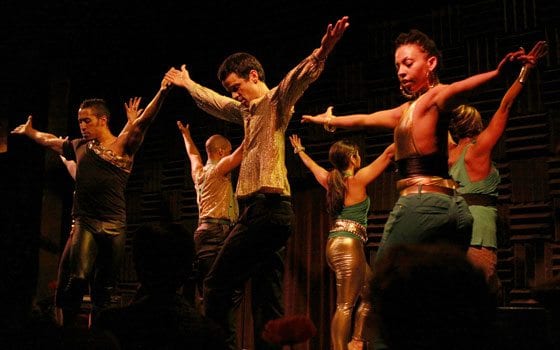
Towering silver platform shoes and water pistols played a part in the performances by Nicholas Leichter Dance (nldnyc) last weekend at the Institute of Contemporary Art/Boston, along with lots of high-octane, virtuoso dancing.
The World Music/CRASHarts presentation showed two Boston premieres choreographed by Nicholas Leichter: “The Whiz: Beantown,” a half-hour adaptation of an evening-length work, “The Whiz;” and the 35-minute “Killa” (2009), Leichter’s homage to global dance music.
Performing both were an ensemble of eight dancers, including Leichter, the company’s choreographer and artistic director, and his recent collaborator Monstah Black, a singer, composer and self-proclaimed Messiah of the Funk.
A thrilling dancer who has performed with Ralph Lemon and Ronald K. Brown and choreographed such classics as “Carmina Burana” and “The Rite of Spring,” Leichter is also highly regarded as a dance educator and award-winning choreographer. Since 1996, when at age 24 he founded his New York-based company, Leichter has been blending modern and contemporary dance traditions with his other loves, club and street dance.
Two charismatic forces shaped this weekend’s program: Leichter and Monstah Black. An on-stage dynamo and superb singer, Monstah Black constantly smiles even when evoking the darker side in his chameleon-like role as ringmaster. Their joint productions combined hallucinatory theatricality with precise, complex dancing that showed both mastery of the rules and an insouciant glee at flaunting them — the better to celebrate collective and individual freedom and verve.
“The Whiz” takes as its point of departure the classic tale by L. Frank Baum, “The Wonderful Wizard of Oz” and its universal subject: the quest to find courage, heart and home. Its soundtrack samples the RandB version of the story, “The Wiz,” both a 1975 Broadway musical and a 1978 film starring Diana Ross (Dorothy) and Michael Jackson (the Scarecrow).
With the spare, distilled poetry of its dancing and staging, “The Whiz” is a fantastic re-imagining of what is itself a fantasy, rediscovering the story for a hip hop crowd with its heart intact.
Monstah Black adapted the score, Erik C. Bruce designed the lighting and Wendell Cooper, one of the dancers, added elements of choreography and sound. Costumes by nldnyc, Susan Soetart and Monstah Black injected bandwidths of color onto the stage, which was plain except for an occasional floor-filling projection resembling a labyrinth.
In a marvelously comic opening sequence, the bravura dancers executed balletic moves arduously, as if out of duty. In quartets and trios they performed highly refined lifts traditionally done as duets. Women in pants lifted men in tutus with grace; and men awkwardly lifted women. The sampling of modern, ballet and club styles concluded with a sweeping ballroom formation that broke into a run before returning to the taut, rhythmic backbone.
Wearing an old-world military jacket (one of many nods to Michael Jackson) with furry epaulets and silver trim, Monstah Black was a combination Tin Man and Cowardly Lion. As he crooned lines from “The Wiz” soundtrack, he took artifice to the point of sincerity. He slowly sampled such evocative phrases as “If only I had a heart” and “If I could feel, what would I do?” Pawing his arms, he sang, “Slide some oil to me.”
Humor and surprise peppered the spectacle. Slightly built Aaron Draper, not sinewy Keon Thoulouis, did a solo as a boxer, outfitted in red trunks and a black helmet and mitts. Laurie Taylor was sensational in close-ups wearing ruffled tops that varied from green and purple to red, the color that dominated the reverent finale.
As the taut, rhythmic backbone of “The Whiz” yielded to a waft of melodic strings, Stephanie Liapis, in a red tutu, did a lean balletic solo that Lauren Basco repeated wearing a red sundress. Monstah Black placed a pair of ruby pumps on the stage with ritual care. Leichter, wearing a gold sequin fedora (another nod to Jackson), danced a spectacular solo. Then he stepped into the sparkling pumps and clicked his heels three times.
“Killa” was a fast moving aural and visual blend of underground dance attitudes, styles, and music set to a pulsing hip hop soundtrack by MIA, Basement Jaxx and Monstah Black.
Deft lighting by Christine Shallenberg and costumes by nldnyc created a black, beige and white palette for the dancers. The ensemble came on stage in funked-up office wear — huge eyeglasses, shirts and big ties. Exciting, edgy and propulsive from the start, they pulsed and postured and cut taut, air-punching, crouch grabbing moves with and behind the beat. Black pants framed the dancers’ bare feet as they pumped in unison like miniature, syncopated puppets.
Monstah Black appeared behind a net of ropes, like a spider in its web, and emerged to taunt and coax the dancers toward transformation. In a heavily accessorized black unitard that covered his body with a white skeleton, he slithered across the stage in ultra-high silver platform shoes, suggesting a figure from the underworld. He cast mischievous spells and with unseen strings turned Dawn Robinson’s sinuous solo into the dance of a robotic marionette. Then, hissing like a serpent, he departed. All eight dancers returned, dressed in camouflage and khaki garb (a reference to U.S. soldiers in the Middle East?).
After a mesmerizing solo by Leichter that unfolded like an intense soliloquy, his company came back for an exultant finale. Each member took a turn at a signature solo as the audience clapped with the dancers in a communal backbeat.






